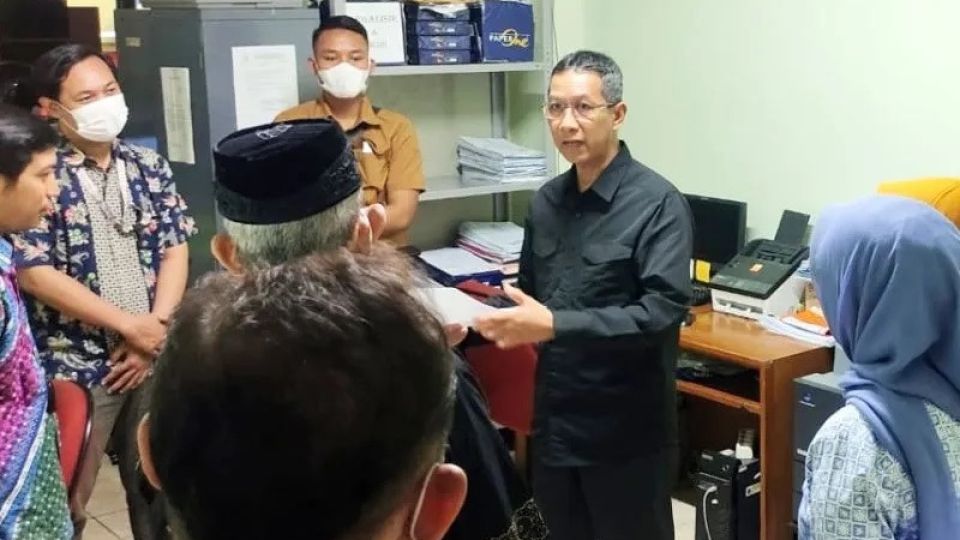December 5, 2022
JAKARTA – There is something interesting about the leadership style of the Jakarta acting governor, Heru Budi Hartono. He seems to project a combined leadership character of his predecessors, Anies Baswedan and Basuki “Ahok” Tjahaja Purnama.
Heru emulates Anies’ politeness but at the same time implements Ahok’s river-normalization policies to deal with city flooding. Heru’s entry into the Jakarta City Hall seems a throwback to the era of the city’s past leadership, including Joko “Jokowi” Widodo, now the President.
By taking a peek at Heru’s track record, we can say his closeness to Jokowi and Ahok is beyond doubt. As the deputy governor of Jakarta, Ahok introduced Heru to governor Jokowi. Ahok was amazed by the concept behind Heru’s demolition of illegal buildings on the banks of Gendong River, North Jakarta, for better flood control.
Heru was indeed experienced in addressing the problem of illegal buildings, as evident in his role behind the establishment of Bersih, Manusiawi dan Berwibawa (Clean, Humane and Dignified – BMW) Park in Tanjung Priok, North Jakarta.
Ahok also asked Heru to explain the concept in front of Jokowi. Jokowi, who was impressed, immediately promoted Heru as head of the Jakarta Regional and Foreign Cooperation Bureau.
In order to control the Pluit Reservoir, Heru was named the North Jakarta mayor in 2014. His last position in the Jakarta administration was head of the Regional Asset Financial Management Agency. Then Jokowi, as the President, appointed Heru as head of the Presidential Secretariat in 2017.
Perhaps given his track record, Heru was chosen by the President as the Jakarta interim governor. The President asked Heru to focus on solving the three main issues facing the capital city: floods, traffic congestion and spatial planning.
In dealing with floods, Heru revived Ahok’s Ciliwung River normalization program as one of Jakarta’s flood-prevention efforts. Right on the day of his inauguration, Heru immediately met Public Works and Housing Minister Basuki Hadimuljono to discuss about the normalization program, the construction of the Ciliwung River sewer and the continuation of the dam constructions at Jakarta’s buffer zones.
The meeting resulted in an agreement to carry on the normalization of the Ciliwung River in the four priority subdistricts in 2023, namely Cililitan and Cawang, East Jakarta; Rawajati, South Jakarta; and kampung Melayu, East Jakarta, with a length of approximately 4.8 kilometers.
To live up Jokowi’s expectations, Heru also met with Agrarian Affairs and Spatial Planning Minister/National Land Agency head Hadi Tjahjanto to resolve the land-certification issues which often hinder the local government in clearing the land for a river-normalization program. The discussion also focused on the construction of outlets or sewer exits at Bidara Cina, East Jakarta, as part of the flood-control measures.
Heru also aims to improve communication between the city and the central governments in order to realize the flood-control program. The Jakarta government’s job is to provide normalized land. Meanwhile, the construction of river banks is the responsibility of the Ciliwung Cisadane River Basin Center (BBWSCC) under the Public Works and Housing Ministry.
The “normalization” program of Jakarta rivers was reconstructed during the term of Anies, who prioritized “naturalization” of rivers and infiltration ponds rather than evicting residents from river banks in order to “concrete” them. This time, Heru chose to return to normalization, as he believes this is one of the best ways to deal with flooding in the capital.
Massive normalization of the Ciliwung River was conducted in 2013, changing the 33.6 km long riverbank into concrete walls. In 2017, the normalization extended by 16 km. After that year, land acquisition slowed down, putting a halt to the normalization efforts by the BBWSCC.
From the four priority-urban villages, the Jakarta government has completed three land-acquisition efforts: Cililitan, Cawang and Rawajati. This suggests that normalization can be continued. However, extra efforts will be needed in kampung Melayu, beginning from Tongtek Jatinegara Bridge, East Jakarta, to the Manggarai Watergate, Central Jakarta, with an area of 1.95 hectares (ha).
The Jakarta Water Resources (SDA) Agency will adopt the Land Acquisition and Resettlement Action Plan (LARAP) program. Via this mechanism, the city government must first resettle the residents living along the river banks as per the law, instead of forcibly evicting them.
Heru once described two possible options of land acquisition. First, the city government buys the residents’ land if the residents can show their land-ownership certificates. Second, residents who are not legal land owners receive apartments from the government, as Anies did when he built three multistory residential towers for around 700 residents of kampung Aquarium in 2021.
Understanding the different measures of river normalization chosen by Ahok and Anies, Heru strives to combine the approaches of the two former governors: continuing the normalization designed by Ahok while adopting a soft approach a la Anies, which is avoiding forced evictions and prioritizing collaboration with residents.
Of course, programs like the river normalization will not spark a controversy as long as the rights of the citizen are respected. Heru seems to be a leader who always looks for a win-win solution. As the acting Jakarta leader, he will accomplish Jokowi’s order, while ensuring the well-being of Jakarta citizens.


